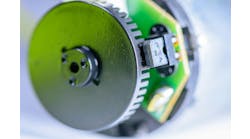Both beams in a dual-beam linear motor system can share an encoder scale and the costly magnet track. All that the second beam needs is the less-expensive linear motor coil and encoder read head.
One of the fastest growing application areas for X-Y motion systems is the automated assembly and inspection of mobile electronic devices such as personal digital assistants (PDAs), cellphones, and pocket PCs. These devices use small, densely populated printed circuit boards (PCBs) assembled with tiny components using surface-mount technology (SMT).
According to Doug Barth, product marketing manager with Anorad/Rockwell Automation (www.anorad.com), SMT component sizes can be as small as 0.02x0.01 in.--about the size of the period that ends this sentence. The means to place hundreds of these components on a PCB in just seconds, and then solder them with very-fine PCB-conductive traces, requires high-speed and high-precision X-Y motion control.
Anorad accomplishes this extremely fast precise control with linear motor-actuated precision gantries. "Our precision gantry systems typically provide X-Y travels of 20-24 in. per axis, and are optimized for rapid motion by using high-speed, iron-core linear motors and high-resolution optical encoders integrated with multiaxis servo-control electronics," says Barth.
Linear motor-driven precision gantries with direct-drive linear motors do not have the inherent drivetrain inertia, backlash, or torsional windup that produces the lost motion ballscrew and belt-driven alternatives can create.
Another advantage of linear motor gantries is that their functionality can help machine builders more easily configure higher-throughput dual-beam designs. Ballscrews and belt drives require a completely independent motor, feedback, and actuation system to drive separate crossbeams atop a given plane of motion.
The design is more economical as well. Both beams in a dual-beam linear motor system can share a common optical encoder scale and costly linear motor magnet track. All that is required to move the second beam is the relatively inexpensive linear motor coil and encoder-read head.
"Linear motors lead to a more space-efficient design with fewer moving parts than a ball-screw of belt-drive equivalent," concludes Barth. "The resultant higher efficiency and increased throughput reduces operating costs, which translates into higher yield and greater machine profitability."
Another manufacturer that relies on linear-motion technology in its X-Y motion systems is Aerotech (www.aerotech.com). "For the past decade, linear motor stages have been used extensively in electronics manufacturing machinery," says Al Ciez, division manager of positioning systems with Aerotech. "Linear motor applications in the packaging, automotive, medical/pharmaceutical, general automation and research markets are now commonplace and growing every day."
Aerotech makes linear motor stages with multiaxis controls, which can be provided as a turnkey motion system that can be factory configured and tuned using the actual application payload or a simulated payload. Turnkey systems can ease integration of linear motion technology, and Aerotech also can tune a factory-floor installed system remotely via the web from its customer service center.
Another firm striving to ease implementation issues with X-Y motion systems is National Instruments (www.ni.com). "Our PC-based Motion Assistant configurable, prototyping software was designed with X-Y systems in mind," says Jayson Wilkinson, motion product manager at National Instruments. "This software offers 2-D and 3-D preview windows to help engineers visualize where their motion is going before actually running it on the stage."
A few years ago, National Instruments partnered with several companies making stages and found the relationship nicely compliments the motion control and machine vision products it offers. "Stages are easy-to-use devices that help people create high-precision applications without having to design it themselves from the ground up," adds Wilkinson.
Bosch Rexroth (www.boschrexroth.com) takes the integration of X-Y motion control and stages a step further by offering a pre-configured, pre-assembled, and pre-parameterized Cartesian system. "Our Cartesian motion systems are ideal for heavy-duty pick-and-place, machining and high-speed dispensing applications," says Danielle Collins, systems product manager at Bosch Rexroth. "The integrated systems provide a solution that allows machine builders to decrease implementation time and increase performance."
One prosaic--but nonetheless important--design consideration for all X-Y motion systems is cable management. The most complex cable management issues arise in multiaxis systems. A good example are X-Y tables where positioning stages are stacked and the cables connecting to the top stage must be capable of flexing as the top stage moves, relative to the lower stage.
Operating precision can suffer when cables impose a load on a moving mechanism. By simply rubbing against each other, cables can produce particulates that can contaminate ultra-clean processes such as polishing disk drive heads or attachment of components to silicon wafers.
Primatics (www.primatics.com) makes X-Y motion stages that incorporate as much of the cabling as possible internally to the stage mechanism. "We strive to minimize external cabling, and all external connections use flexible external cables with plug connectors as opposed to mounting connectors on the drive mechanism," says Alan Petersen, president of Primatics. "This makes stages easier to install in tight spaces."



